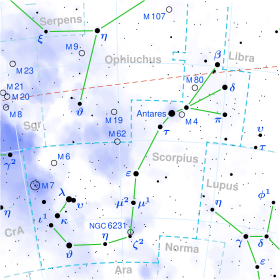| Observation data Epoch J2000 Equinox J2000 | |
|---|---|
| Constellation | Scorpius [1] |
| Right ascension | 17h 18m 57.16483s [2] |
| Declination | −34° 59′ 23.1416″ [2] |
| Apparent magnitude (V) | 5.91/7.20/10.20 [3] |
| Characteristics | |
| Spectral type | K3V + K5V [3] [4] |
| U−B color index | 0.83/???/1.17 |
| B−V color index | 1.03/???/1.57 |
| Variable type | A: suspected B: unknown C: flare star [ citation needed ] |
| Astrometry | |
| GJ 667 AB | |
| Parallax (π) | 138.2±0.7 mas [5] |
| Distance | 23.6 ± 0.1 ly (7.24 ± 0.04 pc) |
| Absolute magnitude (MV) | 6.75 [1] |
| GJ 667 C | |
| Radial velocity (Rv) | +6.4 [6] km/s |
| Proper motion (μ) | RA: 1131.517 mas/yr [6] Dec.: −215.569 mas/yr [6] |
| Parallax (π) | 138.0663±0.0283 mas [6] |
| Distance | 23.623 ± 0.005 ly (7.243 ± 0.001 pc) |
| Orbit [5] | |
| Primary | Gliese 667 A |
| Companion | Gliese 667 B |
| Period (P) | 42.15 yr |
| Semi-major axis (a) | 1.81″ |
| Eccentricity (e) | 0.58 |
| Inclination (i) | 128° |
| Longitude of the node (Ω) | 313° |
| Periastron epoch (T) | 1975.9 |
| Argument of periastron (ω) (secondary) | 247° |
| Details | |
| Gliese 667 A | |
| Mass | 0.73 [7] M☉ |
| Radius | 0.76 [8] R☉ |
| Temperature | 4,270 [8] K |
| Metallicity [Fe/H] | –0.59 [9] dex |
| Gliese 667 B | |
| Mass | 0.69 [7] M☉ |
| Radius | 0.70 [8] R☉ |
| Temperature | 3,998 [8] K |
| Metallicity [Fe/H] | –0.59 [9] dex |
| Gliese 667 C | |
| Mass | 0.327±0.008 [10] M☉ |
| Radius | 0.337±0.014 [10] R☉ |
| Luminosity | 0.01439±0.00035 [10] L☉ |
| Temperature | 3,443+75 −71 [10] K |
| Metallicity [Fe/H] | –0.59 ± 0.10 [11] dex |
| Rotation | 103.9±0.7 [12] days |
| Age | 6.10±2.2 [13] Gyr |
| Other designations | |
| 142 G. Scorpii, CD −34°11626, GJ 667, HD 156384, HIP 84709, HR 6426, LHS 442/442/443, SAO 208670, 2MASS J17185698-3459236 | |
| Database references | |
| SIMBAD | AB |
| A | |
| B | |
| C | |
| Cb | |
| Cc | |
| Ce | |
| Cf | |
| Cg | |
| Exoplanet Archive | data |
| ARICNS | A |
| B | |
| C | |
Gliese 667 (142 G. Scorpii) is a triple-star system in the constellation Scorpius lying at a distance of about 7.2 parsecs (23 light-years ) from Earth. All three of the stars have masses smaller than the Sun. To the naked eye, the system appears to be a single faint star of magnitude 5.89. The system has a relatively high proper motion, exceeding 1 second of arc per year.
Contents
There is a 12th-magnitude star visually close to the other three, but it is a distant background star not gravitationally bound to the system. [14]
The two brightest stars in this system, GJ 667 A and GJ 667 B, are orbiting each other at an average angular separation of 1.81 arcseconds with a high eccentricity of 0.58. At the estimated distance of this system, this is equivalent to a physical separation of about 12.6 AU, or nearly 13 times the separation of the Earth from the Sun. Their eccentric orbit brings the pair as close as about 5 AU to each other, or as distant as 20 AU, corresponding to an eccentricity of 0.6. [note 1] [15] This orbit takes approximately 42.15 years to complete and the orbital plane is inclined at an angle of 128° to the line of sight from the Earth. The third star, GJ 667 C, orbits the GJ 667 AB pair at an angular separation of about 30", which equates to a minimum separation of 230 AU. [11] [16] GJ 667 C also has a system of two confirmed super-Earths and a number of additional doubtful candidates, though the innermost, GJ 667 Cb, may be a gas dwarf; GJ 667 Cc, and the controversial Cf and Ce, are in the circumstellar habitable zone. [17]











